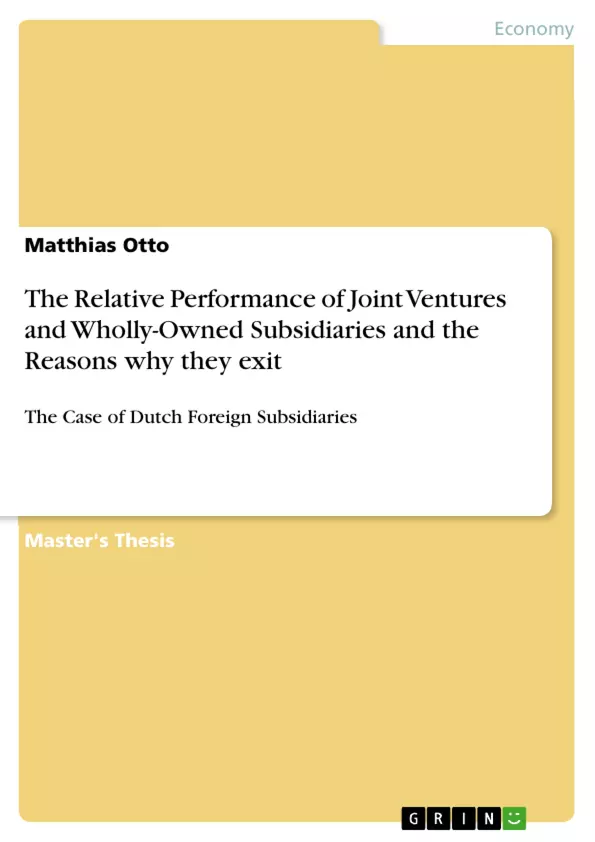Using data on more than 200 foreign entries made by Dutch MNEs between 1995 and 2003, this study examines the relative performance of jointly-owned and wholly-owned affiliates and sheds light on the underlying reasons why these two types of affiliates exit. By employing performance measures such as average longevity and exit rate, and by differentiating between exits through liquidations and those through sell-offs, I find that there are no essential performance differences between WOSs and JVs, which is in line with the results of prior scholarship (e.g. Dang, 1977; Chowdhury, 1992; Chan, 1995; Mata & Portugal, 2000; Pangarkar & Lim; 2003; Delios & Beamish, 2004). Furthermore, the findings reveal that both WOSs and JVs mainly exit voluntarily. The most prevalent reason for WOS exit is strategic restructuring, whereas the most common reason for JV exit is fierce competition in the host market. Finally, I discover supporting evidence for the proposition that MNE parents are more likely to buy out local partners from JVs over which they have majority ownership than from JVs over which they have minority ownership.
Inhaltsverzeichnis (Table of Contents)
- 1. Introduction
- 2. Literature Review
- 2.1 Introduction
- 2.2 Advantages and Disadvantages of WOSS and JVs
- 2.2.1 Advantages of WOSs
- 2.2.2 Disadvantages of WOSs
- 2.2.3 Advantages of JVs
- 2.2.4 Disadvantages of JVs
- 2.3 Theoretical Arguments and Empirical Findings concerning WOS and JV Performance
- 2.3.1 Introduction
- 2.3.2 JVs outperform WOSS
- 2.3.3 WOSS outperform JVs
- 2.3.4 WOSS and JVs perform equally well
- 2.3.5 Summary
- 2.4 Reasons for the Exit of Foreign Subsidiaries
- 2.4.1 Introduction
- 2.4.2 Forced Exits
- 2.4.3 Voluntary Exits
- 2.4.4 Summary
- 3. Propositions
- 3.1 Introduction
- 3.2 Average Longevity and Exit Rate
- 3.3 Exits through Sell-offs and Exits through Liquidations
- 3.4 Reasons for Exits
- 3.5 Changes in Ownership Structure
- 4. Methodology
- 4.1 Introduction
- 4.2 Original Sample
- 4.3 Data Collection and Final Sample
- 4.4 Performance Measures used to test Propositions 1a through 2b
- 4.5 Testing Propositions 3a, 3b, and 4
- 5. Results
- 5.1 Introduction
- 5.2 Average Longevity and Exit Rate
- 5.3 Exits through Sell-offs and Exits through Liquidations
- 5.4 Reasons for Exits
- 5.5 Changes in Ownership Structure
- 6. Conclusion
- 6.1 Introduction
- 6.2 Discussion and Conclusion
- 6.3 Managerial and Academic Implications
- 6.4 Limitations and Suggestions for Further Research
Zielsetzung und Themenschwerpunkte (Objectives and Key Themes)
This thesis aims to explore the relative performance of joint ventures (JVs) and wholly-owned subsidiaries (WOSs) in the context of Dutch foreign subsidiaries. It investigates the reasons why these subsidiaries exit the market, focusing on both forced and voluntary exits. The study analyzes data from a sample of Dutch foreign subsidiaries to determine whether JVs or WOSs exhibit higher performance and longevity, and what factors contribute to their exit decisions.
- Performance Comparison of JVs and WOSs
- Reasons for Foreign Subsidiary Exit
- Forced vs. Voluntary Exit Decisions
- Factors Influencing Exit Decisions
- Ownership Structure and its impact on Exit Decisions
Zusammenfassung der Kapitel (Chapter Summaries)
- Chapter 1: Introduction - This chapter introduces the topic of foreign subsidiary performance and exit decisions, highlighting the importance of understanding these factors for multinational corporations. It establishes the research gap and outlines the specific research questions and objectives of the study.
- Chapter 2: Literature Review - This chapter provides a comprehensive overview of existing literature on the advantages and disadvantages of WOSs and JVs. It examines various theoretical arguments and empirical findings concerning their relative performance, focusing on studies that compare the longevity and profitability of these different ownership structures. The chapter also explores the reasons for foreign subsidiary exit, distinguishing between forced and voluntary exits and analyzing the various factors that contribute to these decisions.
- Chapter 3: Propositions - This chapter formulates specific hypotheses based on the theoretical framework and empirical findings discussed in the previous chapter. It proposes relationships between ownership structure, performance, longevity, and exit decisions, setting the stage for the empirical analysis to be conducted.
- Chapter 4: Methodology - This chapter describes the research methodology used in the study. It outlines the data collection process, explains the selection criteria for the sample of Dutch foreign subsidiaries, and defines the specific performance measures used to test the proposed hypotheses.
- Chapter 5: Results - This chapter presents the findings of the empirical analysis, examining the average longevity and exit rates of WOSs and JVs, the reasons for their exits, and the impact of ownership structure on exit decisions. It analyzes the data collected from the sample of Dutch foreign subsidiaries to test the proposed hypotheses.
Schlüsselwörter (Keywords)
This research focuses on the comparative performance of joint ventures (JVs) and wholly-owned subsidiaries (WOSs), examining the reasons for their exit from foreign markets. Key concepts explored include subsidiary performance, longevity, exit decisions, forced exits, voluntary exits, ownership structure, and the impact of these factors on the success and sustainability of international business ventures.
- Arbeit zitieren
- Matthias Otto (Autor:in), 2009, The Relative Performance of Joint Ventures and Wholly-Owned Subsidiaries and the Reasons why they exit, München, GRIN Verlag, https://www.grin.com/document/155996



